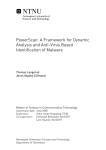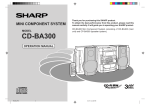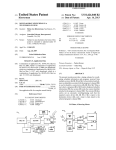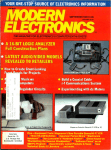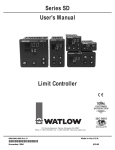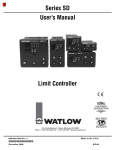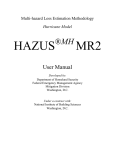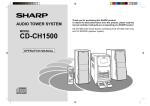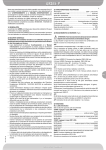Download ALTERNATES
Transcript
United States Patent [191 [11] 4,156,850 Beyers, Jr. [45] May 29, 1979 ch~Tune Assembly, Manual No. 7353, vol. 12, Sep. [54] DISPLAY SYSTEM FOR FACILITATING THE SETUP OF A TUNING SYSTEM [75] Inventor: [73] Assignee: 1976. Farbfernsehgerat mit Mikroprozessor-Steurung-Wolf Billy W. Beyers, Jr., Green?eld, Ind. RCA Corporation, New York, NY. gang Baum, Aug. 12, 1977, “Funkschau,” Heft 17. Primary Examiner-Robert L. Grif?n [21] Appl. No.: 828,848 [22] Filed: Aug. 29, 1977 Assistant Examiner-Marc E. Bookbinder [51] Int. Cl.2 ............................................. .. H04B 1/26 [52] US. Cl.‘ [58] Field of Search ............. .. 325/453, 455, 459, 464, 325/468; 358/191, 192 ‘ ‘ , 5/1977 ABSTRACT In a tuning system for a television receiver including a memory for storing binary signals representing tuning which the binary signals representing the tuning volt Tanaka ............................... .. 325/455 4,041,402 8/1977 Mogi 325/455 4,081,797 3/1978 Olson ......... .. 358/192 4,122,395 10/1978 Schotz et a1. ...................... .. 325/453 ages are generated in response to viewer control, a multiplexer couples predetermined selected ones of the binary signals representing the tuning voltages to a digital channel number display unit to provide a viewer with an indication of the relative tuning position. The FOREIGN PATENT DOCUMENTS 1363048 8/1974 United Kingdom. 1377100 12/1974 United Kingdom. 1386935 3/ 1975 United Kingdom. 1410363 l0/l975 United Kingdom. 1445031 8/1976 United Kingdom. 1471712 4/1977 United Kingdom. multiplexer also couples binary signals representing the letter “A” to the channel number display during the tuning voltage setup mode to distinguish the tuning voltage setup mode from other modes of operation of the tuning system. In addition, during a channel selec tion setup mode, in which a viewer selects the channels 1485740 9/1977 United Kingdom. he does not wish skipped during normal operation of OTHER PUBLICATIONS “Digitales [57] voltages corresponding to various channels a viewer may select, during a tuning voltage setup mode in References Cited U.S. PATENT DOCUMENTS 4,023,107 Attorney, Agent, or Firm—Eugene M. Whitacre; Paul J. Rasmussen; Peter M. Emanuel ............................... .. 325/455; 325/464; 358/192 [56] ' the tuning system, the multiplexer couples binary sig Programmspeicher-System"-Friedrich nals representing the letters “Cl-I” to the channel num Timmermann, Funkschau, Heft 17, Aug. 12, 1977. Working With Microprocessors-Select the Station the Micro Way-Quentin Scott-Electronics Weekly-Apr. 13, 1977. General Instruments, AY-3-8330, Data Sheet. Magnavox Service Manual-703777, Videomatic Tou ber display to distinguish the channel selection tuning POWER UP mode from the tuning voltage setup mode and the nor mal operating mode. 16 Claims, 4 Drawing Figures KEYBOARD TIMING AND CONTROL ALTERNATES up--- _ DN- - 4 DISPLAY INPUT MUX MUX .3 CHANNEL NUMBER DISPLAY —r2‘o-—-'"" TUNING VOLT. REG. 136 US. Patent May 29, 1979 4,156,850 Sheet 3 of 4 l2 6 ) MSDI l NORMAL CHANNEL M130 0‘ 30l L/3l2b F \soz TENS J,F____ 13120 L___ . l___ 322 330 ‘ LSD ll 3i 3|4c~ . T L_. L4 B91 “1 T 3200 L, L1 320;! I 9 32Gb TO DISPLAYIDECODER 124 Flg. 3 U Sheet 4 of 4 +v +v 4,156,850 +v 15g) CH ALTERNAT k J Y TO DISPLAY DECODER i241} 1 4,156,850 DISPLAY SYSTEM FOR FACILITATING THE SETUP OF A TUNING SYSTEM BACKGROUND OF THE INVENTION 7 2 only do electromechanical meters tend to be relatively expensive and, because of their bulk, tend to detract from the appearance of the receiver, but they may be difficult to read by viewers not familiar with electronic equipment. Moreover, electromechanical meters may The present invention relates to the ?eld of tuning systems for television receivers and the like which in not provide suf?cient resolution between tuning posi tions where the preferred channels are closely spaced. clude a memory for storing binary signals representing tuning information. That is, for example, a viewer may not be able to distin guish between channels 4, 5 or 6. It is also possible to provide an on-screen display system which provides an on-screen display showing a scale calibrated in channel numbers (rather than in tun Recently, electronic tuning systems have been pro posed for television receivers which include a memory for storing binary signals representing tuning voltages for controlling an associated voltage controlled local _ oscillator in order to tune various channels a viewer may select. Although these memory type of tuning systems tend to be more versatile and less expensive than other types of electronic tuning systems such as, for example, those employing frequency synthesizers,‘ ing voltages) and a bar which changes length along the scale as a tuning voltage is adjusted (see, for example, the display disclosed in the “General Instrument AY-3 8330—Electronic On-Screen TV Tuning Scale” data sheet available from General Instrument). While such an on-screen display may overcome some of the disad vantages of an electromechanical meter, it may never ming by the manufacturer, and in some instances by the. 20 theless be dif?cult for a viewer to utilize because it they suffer the disadvantage that at least some program individual viewer, is required to enter tuning informa provides information in the same analog format as does tion into the memory. an electromechanical meter. In addition, on-screen dis In some of the proposed memory type tuning systems the size of the memory, i.e., the number of locations in which information can be stored, is limited to reduce the cost of the tuning system. As a result, in these tuning systems only the tuning information for a limited num ber of preferred channels less than the total number of play systems tend to add expense to the cost of the tuning system and therefore may not be provided. Thus, it is desirable that a memory type tuning system include an arrangement for providing an indication of tuning voltages in a format with which ordinary view channels allocated to the television band can be stored. ers are relatively familiar and which desirably include provisions which tend to minimize the possibility of Since the channels preferred by a particular viewer, confusion on the part of a viewer. either because of program content or because of the reception conditions at the viewer’s location, are known SUMMARY OF THE PRESENT INVENTION only to a viewer, for those memory type tuning systems In a tuning system of the type including memory means for storing tuning information for various tuning including a memory with only a limited number of memory locations, programming is to be accomplished 35 positions a user may select, multiplexing means selec by the viewer himself. Programming a memory type tively couples binary signals corresponding to the tun tuning system involves not only the selection of the ing positions to a digital display unit so that tuning preferred channels, but also involves the generation of position symbols for identifying the tuning positions are binary signals representing tuning voltages and channel displayed during the normal operating mode of the number display information corresponding to the pre 40 tuning system when information is retrieved from the ferred channels. For viewers who are used to the con memory to tune the receiver and couples binary signals ventional type of mechanical tuning systems including a representing the tuning voltages corresponding to the mechanical rotary channel selector switch, the pro tuning positions to the display unit so that numbers gramming procedures for a memory type tuning system related to the tuning voltages are displayed during a may present considerable dif?culty and lead to unneces 45 programming mode in which the binary signals repre sary costly and annoying service calls. Therefore, it is senting the tuning voltages are generated for entry into desirable that memory type tuning systems be arranged the memory means. to simplify as much as possible the required program ming procedures. One of the problems encountered in programming a memory type tuning system is that of correlating a viewable picture to a channel number. That is, as the tuning voltage is adjusted until a viewable picture is produced, unless a station identi?cation interval is for tuitously transmitted while the viewable display is pres ent or the viewer happens to know on what channel the program being displayed is being transmitted, the viewer has no way of knowing the channel to which the receiver is presently tuned and cannot program the corresponding channel number display information. To overcome this problem, it is possible to provide an electromechanical voltage meter which is responsive to the analog tuning voltage so as to provide a viewer with an indication of the relative tuning position (see, for example, the tuning system disclosed in the “Magnavox Service Manual—703777 Videomatic Touch Tune As sembly," Manual No. 7353, File Volume 12, published by the Magnavox Company, Fort Wayne, Ind.). Not Desirably, the binary signals representing the tuning voltages which are coupled to the display unit signals are arranged in a predetermined format such that the numbers displayed during the programming mode are linearly related to the tuning voltages. To further aid a viewer during the setup mode, binary signals representing a predetermined symbol may be coupled to the display means during the programming mode to distinguish it from the normal mode of opera tion. BRIEF DESCRIPTION OF THE DRAWING FIG. 1 shows, in block diagram form, a television receiver employing a memory type tuning system with provisions for facilitating its setup by a viewer in accor dance with the present invention; FIG. 2 shows a table indicating certain binary code formats useful in facilitating an understanding of the operation of the setup provisions shown in FIG. 1; and FIGS. 3 and 4 show, in logic diagram form, respec tive implementations of portions of the tuning system 4,156,850 3 facilitate its setup by a viewer. 4 dress register 114 is an up/down counter with provi shown in block diagram form in FIG. 1 arranged to sions for entering binary signals coupled to “jam” in ' wise processed. The processed RF signals are coupled puts, such as the CD4029 integrated circuit available from RCA Corporation. The contents of address regis ter 114 (as represented by the four binary signals) may be increased by the decimal number 1 or decreased by the decimal number 1 in response to the appropriate control signals,'as will be described. When a location of tuning voltage memory 112 is to a mixer 16 where they are combined with a local addressed, the contents of the addressed location are DETAILED DESCRIPTION OF THE INVENTION In FIG. 1, RF (Radio Frequency) signals are re ceived by an antenna 12 and coupled to an RF process ing unit 14 where they are ?ltered, ampli?ed and other oscillator signal generated by a local oscillator 18 to “read” out of tuning voltage memory 112 and coupled produce an IF (Intermediate Frequency) signal. The frequency of the local oscillator signal is controlled in to a digital-to-analog (D/A) converter 116 which con verts them to the corresponding tuning voltages for local oscillator 18. A tuning voltage register 118, including 12 stages tem 20 in accordance with the channel selected by a 5 arranged as an up/down counter for counting in viewer so that when it is combined with the RF signals, response to a tuning voltage generated by a tuning sys . the IF signal has modulated picture, color and sound carriers at predetermined frequencies. The IF signal is coupled to an IF processing unit 22 where it is ?ltered, ampli?ed and otherwise processed. A portion of the IF signal is coupled to an AFT (Automatic Fine Tuning) straight binary format, is coupled to tuning voltage memory 112 to generate l2 binary signals stored in each memory location of tuning voltage memory 112 repre senting the tuning voltage for each of the preferred channels during a setup mode of operation of tuning system 20. During the setup mode of operation of tun discriminator which generates an AFT signal represent ing a deviation between the picture carrier frequency and its nominal value, e.g., in the United States, 45.75 ing system 20, the contents of tuning voltage register is coupled to local oscillator 18 to modify the tuning corresponding tuning voltages until the viewer is satis 118 are increased or decreased in increments of 1 in MHz, which may occur due to component aging or 25 response to control signals generated under viewer control and are converted by D/A converter 116 to environmental operating conditions. The AFT voltage voltage so as to minimize the deviation between the picture carrier frequency and its nominal value. The output of IF processing unit 22 is coupled to a signal processing unit 26 which processes the various compo nents of the IF signal so that a picture is produced by ?ed with the picture produced by kinescope 28. Se lected ones of the binary signals generated by tuning voltage register 118 are coupled to a channel number display unit 120 so that numbers related to the tuning voltage are displayed by which a viewer may verify that the picture corresponds to the channel he wishes programmed as is described below. The contents of duced by means of a speaker 30. Tuning system 20 is a memory type tuning system 35 tuning voltage register 118 are entered (“written”) into the presently addressed memory location of tuning which is capable of storing tuning information for tun voltage memory 112 in response to viewer control. ing a number of preferred channels less than the total The channel number corresponding to a channel number of channels allocated to the television band. For selected by a viewer is displayed by channel number example, while in the United States there are 82 chan display unit 120 in response to binary signals generated nels (2-83) allocated to the television band by the FCC by a channel number register 122. Channel number (Federal Communications Commission), tuning system register 122 comprises two 4-stage up/down counters 20 may be programmed to tune only 16 channels which means of a kinescope 28 and an audio response is pro with provisions for entering binary signals at jam inputs are preferred by a viewer over the others because of such as CD4029 integrated circuits available from RCA their program content or because of their relative recep 45 Corporation. Each counter generates four binary sig tion characteristics at the viewer’s location. Specifically, tuning system 20 includes a tuning volt age memory 112 for storing the binary signals represent ing the tuning voltages for each of 16 channels pre ferred by the viewer. Tuning voltage memory 112 in nals arranged in BCD (Binary Coded Decimal) format (see the code con?gurations for decimal numbers 0-9 in the table of FIG. 2 in the column labelled “BINARY”) representing the ten decimal numbers 0-9. The binary cludes 16 memory locations. Each of the memory loca 50 signals generated by the ?rst counter represent the least signi?cant digit (LSD) of the decimal number and the tions includes 12 memory cells for storing 12 respective binary signalsgenerated by the second counter repre binary signals or bits (binary digits) which have either a logic “1” level corresponding to a relatively high volt age +V or a logic “0” level corresponding to the volt age at signal ground. The binary signals stored in each memory location are arranged in straight binary format. Straight binary format means that each of the 12 binary signals represents a power of 2 from 0 to 11 and are arranged in ascending order from right to left. Each location of tuning voltage memory 112 has an address. As will be described later, the tuning voltage information for the preferred channels is stored in con secutively addressed memory locations in ascending channel number order. An address register 114 includ sent the most signi?cant digit (MSD) of the channel ‘ number. The two counters are cascaded to count be tween channel numbers 02 and 83 in either increasing or or decreasing order in response to control signals gener ated in response to viewer control. In order to reduce the circuitry employed in display unit 120, the binary signals representing the LSD and MSD of the channel number are time multiplexed and sequentially processed by channel number display unit 120. Speci?cally, the binary signals representing the LSD are coupled to a display decoder 124 by a display unit multiplexer (MUX) 126 during a UNITS timing ing four stages is coupled to tuning voltage memory 112 65 signal and the binary signals representing the MSD are coupled to display decoder 124 by display input multi to generate four binary signals representing, in straight plexer 126 during a TENS timing signal. A display binary format, the decimal numbers 0-15 to address any decoder 124 converts the four binary signals coupled to of the 16 locations of tuning voltage memory 112. Ad 5 4,156,850 6 mined level when power is applied to the receiver after it has been off and in response generates a PUP (Power its input terminals to seven binary signals, each one of which corresponds to a segment of a seven-segment display unit. The seven binary output signals of display UP) signal. Keyboard 144 includes push buttons la decoder 124 are coupled to a display output multiplexer (MUX) 128 which in turn couples them to units position belled UP, DN (DowN), STORE and ERASE which when depressed by a viewer cause corresponding com mand signals to be generated and coupled to timing and control unit 138. These command signals determine whether the contents of address register 114, tuning voltage register 118 and channel number register 122 seven-segment display unit 130A during the UNITS timing signal and to the tens position seven-segment display unit 130B during the TENS timing signal. Sev en-segment display units 130A and 1303, which may be, for example, of the light emitting diode or liquid crystal are increased or decreased and whether data is stored in or erased from tuning voltage memory 112 and skip type, include seven segments a—g which are selectively illuminated in response to the logic levels (i.e., either a logic “0” or a logic “l”) of the respective binary signals , coupled to them to form the decimal numbers 0-9. To MAl, CHANNEL and TUNE position for generating form the number 9, for example, segments a, b, c, f and g would be illuminated. The frequency and duty cycle of the display timing signal are selected so that a viewer does not notice any ?icker in the channel number dis trolling the operation of tuning system 20 is de?ned by corresponding signals to be generated in order to con trol the operating mode of tuning system 20. The func tional operation of control and timing unit 138 in con the description set forth below. The structure of control play. The LSD and MSD binary signals generated by memory 132. Mode selection switch 146 has a NOR and timing unit 138 may comprise a logic con?guration 20 arranged to carry out the operations set forth below channel number register 122 are also coupled to a skip memory 132. Skip memory 132 is a memory containing 82 locations, each having a memory cell for storing one bit. The addresses of the 82 locations of skip memory 132 correspond to the 82 channel numbers between 02 25 similar to the control and timing structure disclosed in and 83. Thus, for example, when channel number regis ter 122 contains binary signals representing channel number 13, a corresponding memory location of skip No. 4,123,713, hereby incorporated by reference. Alter memory 132 will be addressed. The purpose of skip memory 132 is to provide an indication, i.e., a logic “1”, when a particular channel is to be skipped because it is detail in copending United States Pat. application Ser. No. 810,877 entitled, “Memory Type Tuning System with Provisions to Facilitate Setup” ?led in the name of Charles Martin Wine on June 28, 1977 now US. Pat. nately, control and timing unit 138 may comprise a microprocessor operated in accordance with a program for carrying out the operations set forth below stored in an associated memory such as is disclosed in an article entitled, “Working with Microprocessors-Select the Station the Micro Way” by Quentin Scott appearing in the Apr. 13, 1977 issue of Electronics Weekly. The numerous control interconnections between timing and memory 132, a skip detector 134 generates a SKIP 35 control unit 138 and various portions of tuning system signal. 20 have been omitted for the sake of clarity of drawing. The LSD and MSD binary signals generated by However, the function of these control interconnec channel number register 122 are also coupled to a band tions will become clear from the following description selector 136, which may, for example, comprise a read of the operation of tuning system 20. only memory (ROM) to determine from the channel number the frequency band in which the selected chan 40 In operation, assuming that mode selector switch 146 has been placed in its NORMAL position, when'the nel resides and in response generate a representative not one of the channels preferred by a viewer. In re sponse to the presence of a logic “1” in a location of skip band selection signal. Thus, for example, in the United States, band selector 136 generates respective band selection signals for channels 2-6, 7-13 and 1483. The receiver is turned on, binary signals representing the lowest channel number, i.e., channel number 02 (as would be displayed .by‘ channel number display unit band selection signals are coupled to local oscillator 18 45 120), are coupled to channel number register 122 from unit 123 and binary signals representing the number 15 to control the frequency range in which it oscillates. are coupled to address register 114 from unit 115 and Local oscillator 18 includes arrangements of varactor entered into the respective registers in response to the diodes which are switched into an oscillator con?gura tion in response to the respective band selection signals generation of a PUP signal. At this point, vthe contents to determine the frequency range in which local oscilla tor 18 oscillates. The speci?c'frequency at which local oscillator 18 oscillates is determined by the magnitude of the location of skip memory 132 corresponding to channel number 02 are examined by skip detector 134. If a logic “1” is detected, a SKIP signal, representing that channel 2 is not preferred and is to be skipped, is generated. If a logic “0” is detected, a SKIP signal (i.e., of the tuning voltage. The timing signals for controlling the sequential oper ation of tuning system 20 are generated by a timing and control unit‘ 138 by dividing a clock signal generated by a clock oscillator into various timing intervals. The control signals for controlling the transfer of informa tion to and from tuning voltage memory 112 and skip memory 132 and to control the counting operations of 60 address register 114, tuning voltage register 118 and channel number register 122 in the manner set forth below are generated in a timed sequence in response to the logic complement of the SKIP signal), representing that channel 2 is preferred and not to be skipped, is -, generated and coupled to timing and control unit 138. Y In response to a SKIP signal the contents of channel ‘ number register 122 are increased by a count of 1 and '_ the contents of the location of skip memory 132 corre sponding to the next channel are examined. This pro cess continues until a SKIP signal is generated. In re sponse to a SKIP signal,‘ the contents of address register 114 are increased by a count of 1 but the contents of the timing signals and in response to command signals generated by a power up detector 142, a keyboard 144, 65 channel number register 122 are not further increased. . At this point, the contents of channel number register a mode selector switch 146 and skip detector 134. Power up detector 142 detects when the power supply voltage for tuning system 20 rises above a predeter 122 (which is the ?rst address of SKIP memory 132 at which a logic “0” was detected) are displayed by chan 7 4,156,850 nel number display 120 and the contents of the ?rst location of tuning voltage memory 112 are “read out” and converted to a corresponding tuning voltage. When a viewer wishes to change the channel, he may do so by depressing either the UP or DN push button on keyboard 144. When the UP push button is depressed, the contents of channel number register 122 are succes sively increased by a count of 1 until a SKIP signal is generated by skip detector 134. When a SKIP signal is generated, the contents of address register 114 are in 8 To program or reprogram the tuning voltage, the viewer should place mode selector switch 146 in its TUNE position and thereafter depress the UP and DN push buttons on keyboard 144 to change the tuning voltage by changing the contents of tuning voltage register 118 until an acceptable picture is obtained on the screen of kinescope 28. At this point,~ the viewer must make surethe picture corresponds to the selected channel for which tuning voltage information is to be entered before the tuning creased by a count of 1 but the contents of channel number register 122 are not further increased. At this voltage information is “written” into tuning voltage point, the channel number of the second preferred chan correspond to a different channel number than the one memory 112. This is necessary because the picture may displayed by channel number display 120 when mode nel is displayed and the corresponding tuning voltage is generated. The operation of tuning system 20 when a DN push button has been depressed to change the chan nel is similar to the operation of tuning system 20 when selector switch 146 was in its CHANNEL position. This may occur, for example, because the viewer has the UP push button has been depressed to change the channel, except that the contents of channel number cause the RF carrier for the selected channel was not tuned past the correct tuning voltage for the selected channel to the tuning voltage for another channel be register 122 and address register 114 are decreased by a 20 suf?ciently strong to produce an acceptable picture. Of course, a viewer can verify that the display corresponds count of 1 rather than being increased by a count of 1. to the selected channel by waiting until a station identi As was earlier noted, it is intended that tuning volt~ ?cation signal is broadcast. However, considering that age information for the channels preferred by a viewer such a procedure must be followed for each of the pre be stored in consecutive locations of tuning voltage ferred channels to be programmed, this may involve memory 112 in the same order as the corresponding considerable time and is therefore undesirable. channel numbers. To accomplish this, a viewer ?rst In the present tuning system, the viewer may verify places mode selector switch 146 in its CHANNEL that the display corresponds to the selected channel to position. In response to the generation of a CHANNEL be programmed simply by referring to the display pro signal, the contents of channel number register 122 and 30 duced by channel number display 120 after he has the contents of address register 114 will be increased placed mode selector switch 146 in its TUNE position. until the channel number of the ?rst channel which has When mode selector switch 146 is placed in its TUNE a logic “0” in the associated location of skip memory position, display input multiplexer 126 decouples the 132 is displayed and the associated location of tuning binary signals generated by channel number register 122 voltage memory 112 is addressed in the same manner as 35 representing the LSD and MSD of the channel number when a PUP signal is generated when power is ?rst applied to the receiver. If none of the channels have been programmed, channel number 02 will be displayed by channel number display 120 and an unviewable pic ture will be produced on the screen of kinescope 28 from the remainder of channel number display 120 and instead couples selected ones of the binary signals gen erated by tuning voltage register 118 representing the tuning voltage to the remainder of channel number display 120. As a result, channel number display 120 displays a decimal number approximately related to the tuning voltage to provide a viewer with a relative indi since no skip bits, i.e., logic “l’s” have been entered in skip memory 132 and no meaningful tuning voltage information is contained in tuning voltage memory 112. cation of the tuning position. The selected binary signals At this point, the viewer should program tuning system generated by tuning voltage register 118 which are 20 to generate the appropriate tuning voltage to pro 45 coupled to display input multiplexer 126 to the remain duce an acceptable display by placing mode selection der of channel number display 120 are chosen so that switch 146 into its TUNE mode and proceeding as is set forth below. If some channels have been programmed, the channel number for the ?rst channel which has a TUNE mode is related in a linear fashion to the tuning its quality. board 144. In response to the generation of a STORE the relative tuning voltage number displayed during the voltage without portions in the range which will be logic “0” in the associated location of skip memory 132 50 unintelligible or confusing to the average viewer as will is displayed and the associated location of tuning volt be explained below. By reference to a relative tuning age memory 112 is addressed so that a viewable picture voltage table which relates the tuning voltage number is produced. At this point, the viewer may reprogram displayed by channel number display 120 when tuning tuning system 20 for this channel to generate an updated system 20 is in the TUNE mode to respective channel tuning voltage in the manner set forth below in order to 55 numbers, the viewer will be able to verify that the pic attempt to improve the picture quality or may depress ture obtained during the TUNE mode and the corre the UP push button on keyboard 144 to select the next sponding tuning voltage corresponds to the channel to channel to be programmed, if an unacceptable picture is be programmed. produced, or reprogrammed, if the picture produced is To enter the binary signals representing the tuning viewable but the viewer wishes to attempt to improve 60 voltage, a viewer depresses the STORE button on key If the viewer depresses the UP push button, the con signal, the contents of tuning voltage register 118 are tents of channel number register 122 are increased by a transferred to and “written” into the presently ad count of 1 until another SKIP signal is generated. At dressed location of tuning voltage memory 112. Simul this point, the channel number of the next already pro 65 taneously, in response to the STORE signal, a logic “0” g'rammed preferred or unprogrammed channel is dis (provided by a connection to signal ground) is coupled played and the associated location of tuning voltage to and “written” into the presently addressed location of skip memory 132. memory 112 is addressed. 4,156,850 9 If the picture for the channel to be programmed is unacceptable to a viewer or corresponds to another channel as determined by the relative tuning voltage number displayed during the TUNE mode, the viewer should depress the ERASE push button. In response to the generation of the ERASE signal, a logic “1” (pro 10 for the number 9, the letters A-F would tend to be confusing to a viewer. FIG. 3 shows a logic implementation of display input multiplexer 126 for coupling the six most signi?cant bits Ell-B6 to the remainder of channel number display 120 in octal format in order to display a two digit number voltage) is coupled to and “written” into the presently linearly related to the'tuning voltage during the TUNE mode of operation of tuning system 20. Display input addressed location of skip memory 132. multiplexer 126 of FIG. 3 comprises a 4X4 rectangular vided by a connection to a source of the +V supply ‘ After a channel has been programmed, the viewer 0 array of transfer (T) gates 312a-d, 314a-d, and 318a-d. Each transfer T gate has an input terminal 301, an out should place mode selector switch 146 into its CHAN put terminal 302 and a control terminal 303 for control NEL position so that the next channel can be pro ling the transfer of data between input terminal 301 to grammed or reprogrammed. output terminal 302. As long as a logic “0” is applied to In tuning system 20, in order to provide a numerical the control terminal 303 of a transfer gate, the input display which is linearly related to the tuning voltage terminal 301 is decoupled from the output terminal 302 generated during the TUNE mode, the three most sig~ ni?cant bits corresponding to 211-29, indicated by Bll-B9 in FIG. 1, generated by tuning voltage register 118 are coupled by display input multiplexer 126 to display decoder 124 instead of the binary signals repre senting the MSD of the channel number during the TENS timing signal and the next three most signi?cant bits, corresponding to 23-26, indicated by B8-B6 in FIG. 1, generated by tuning voltage register 118 are coupled by display input multiplexer 128 to display decoder 124 instead of the binary signals representing the LSD of the channel number during the UNITS timing signal. With this con?guration, as the contents of tuning voltage register 118 are varied in a range from a ?rst extreme corresponding to the lowest magnitude tuning voltage to a second extreme corresponding to the highest magnitude tuning voltage, the numbers in the tens and units display positions vary between 0 and 7 in accordance with the octal coding format indicated so that whatever signal is coupled to input terminal 301 is prevented from affecting the condition of the signal level at output terminal 302. When a logic “1” is applied to control terminal 303 of a transfer gate, whatever signal is coupled to its input terminal 301 is transferred to its output terminal. The output terminal 302 of each transfer gate in a column is coupled to a respective one of four common output lines 320a-d. Output lines 320a-d of display input multiplexer ‘126 of FIG. 3 are the four input lines of display decoder 124 of FIG. 1. The input terminals of each transfer gate in a row is coupled to a respective one of four common control lines 322-328. The control signal on each one of control lines 322-328 is generated by a respective one of four AND gates 330-336. It will be noted that there are four bits associated with the tens and units positions of the channel number dis play while there are only three bits associated with the tens and units positions of the tuning voltage display. To accommodate this difference, a logic “0,” provided by in the column labelled “OCTAL” of the table of FIG. 2. It will be noted that with the three bit octal format there means of a connection to signal ground, is continually are no code con?gurations after the code con?guration coupled to input terminals 301 of transfer gates 316a and for the number 7. Thus, with this octal format, there 318a of the rows associated with the tens and units will be no code con?gurations generated for which positions of the tuning voltage number display. there is no available meaningful numerical display as is The output of AND gate 330 will become a logic “‘1” the case for the straight binary and hexidecimal code and, as a result, the binary signals'representing the tens formats discussed above. That is, when the octal format position of the channel number, i.e., MSD3-MSDO is utilized, channel number display 120 will change in a corresponding to bit positions 23-20, will be transferred linear relationship to the tuning voltage between num 45 to display decoder 124 only when the TENS timing bers 00 and 77 without any gaps in which the display is signal has a logic “1” level and either the NORMAL not linearly related to the tuning voltage. signal or CHANNEL signal, coupled to an OR gate By comparison, this is not the case when either 338, has a logic “1” level. The output of AND gate 332 straight binary or hexidecimal codes are utilized. With will become a logic “1” and, as a result, the binary reference to the column labelled “BINARY” of the signals representing the units position of the channel table of FIG. 2, it will be noted that although each number, i.e., LSD3-LSDO corresponding to bit posi display position of channel number display 120 is capa tions 23-29, will be transferred to display decoder 124, ble of displaying only ten decimal numbers, i.e., 0-9, if a four bit straight binary code is utilized, e.g., by cou pling binary signals B11-B8 to channel number display 120, after the number 9 is displayed in either display position, since the four bits corresponding to either display position may assume code con?gurations corre sponding to numbers greater than 9, i.e., numbers 10-15, six more code con?gurations could be generated for only when the UNITS timing signal has a logic “1” level and either the NORMAL or CHANNEL signal has a logic “1” level. The output of AND gate 334 will become a logic “1”, and, as a result, binary signals B11-B9 representing the tens position in octal format of the tuning voltage number will be transferred to display decoder 124 only when the TENS timing signal and the TUNE signal have logic “1” levels. The output of which there are no symbols which meaningfully corre AND gate 336 will become a logic “1” and, as avresult, spond to the magnitude of the tuning voltage and there binary signals B8-B6 representing the units position of the tuning voltage number will be transferred to display decoder 124 only when the UNITS timing signal and the TUNE signal have logic “1" levels. The binary would be an interval when the display would not lin early correspond to the tuning voltage. If a four bit hexidecimal code, as is indicated in the column labelled “HEXIDECIMAL’! of the table of FIG. 2, is utilized, although letters A-F could be displayed for the six code con?gurations remaining after the code con?guration signals coupled to the display decoder 124 are decoded in accordance with the code indicated in the column labelled “DECODER” in the table of FIG. 2. 11 4,156,850 With the logic arrangement of display input multi~ 12 changes at a rate which is equal to one-half the rate at which the least signi?cant binary signal coupled to channel number display 120, i.e., B9, changes, it has a plexer 126 shown in FIG. 3, as the contents of the tun ing voltage register 118 are changed to change the tun ing voltage from one magnitude extreme to the other, the tuning voltage number will change in a correspond ing linear fashion between the two digit number 00 and the two digit number 77. Since the channel number is rate equal to one-half the rate at which the tuning. volt age number displayed changes, and it is thus a desirable , choice for this purpose. To distinguish the CHANNEL mode from the TUNE mode, binary signals representing the letter “C”, provided by a unit 152, and binary signals representing also a two digit number, a viewer may be confused as to whether tuning system 20 is in its normal operating mode, channel selection mode or tuning voltage adjust the letter “H”, provided by a unit 154, are coupled to display input multiplexer 126 to be displayed in tens ment mode. To avoid such confusion, it is desirable to display only a one digit number rather than a two digit position 130B and units position 130A as the symbol number to indicate the tuning voltage during the TUNE “CH” (for CHannel) alternately with the two digit mode. To further avoid confusion, it is desirable to display a symbol to indicate to a viewer when tuning system 20 is in the CHANNEL mode and another sym bol when tuning system 20 is in the TUNE mode. To display a one digit number rather than a two digit channel number when mode selector switch 146 is in the CHANNEL mode. To alternate the display of the symbol “CH” with the two digit channel number, a number representing the tuning voltage, only the three most signi?cant binary signals, Bll-B9 (rather than the 20 two groups of binary signals B11-B9 and B8-B6), are coupled to display input multiplexer 126. Display input multiplexer 126 couples binary signals Bil-B9 to dis timing signal ALTERNATE having, for example, a period of approximately 2 seconds, generated by timing and control unit 138 is coupled to display input multi plexer 126. FIG. 4 shows 4X7 transfer (T) gates arranged to: (l) continuously display a two digit channel number during the NORMAL mode; (2) alternately display a two digit play decoder 124 and the resulting seven bit display channel number and the symbol “CH” during the code is coupled to units position display unit 130 during 25 CHANNEL mode; (3a) continually display the symbol “AJ” when the tuning voltage is not being adjusted by the UNITS timing signals. Since the binary signals change from a code con?guration corresponding to the decimal number 0 to a code con?guration correspond ing to the decimalnumber 7 as the tuning voltage is changed, there will be no code con?gurations which are not capable of being displayed in an intelligible form means of the UP and DN push buttons during the TUNE mode; and (3b) display a one digit tuning volt age number in units position 130A of the display and alternately display the symbols “A” and “-” in tens position 130B of the display when the tuning voltage is being adjusted by means of the UP and DN push but tons during the TUNE mode. The logic arrangement by units display 130A and as a result the tuning voltage number will change linearly with the tuning voltages through the tuning voltage range. shown in FIG. 4 is similar to that shown in FIG. 3. OR In order that a viewer be better able to distinguish 35 gate 412, NAND gate 414, INVERTER 416 and AND between the channel selection and the tuning voltage adjustment modes, when mode selector switch 146 is placed in the TUNE position, as long as the viewer is not adjusting the tuning voltage by means of the UP and DN push buttons of keyboard 144, the letter “A”, cor responding to appropriately coded binary signals cou pled to display input multiplexer 126 from a unit 148, is displayed continually in tens position 130B and the letter “J ,” corresponding to appropriately coded binary signals coupled to display input multiplexer 126 from a unit 156, is continually displayed in the units position so that the symbol “AJ” for AdJustment is displayed. When the viewer adjusts the tuning voltage by means of the UP and DN push buttons, as the correspondingly gates 418, 426, 422 and 424 control the transfer of infor mation to display decoder 124 to accomplish functions (1) and (2) set forth above. NOR gate 434 and‘AND gates 436 and 438 control the transfer of information to 40 display decoder 124 to accomplish function (3a) set forth above. NOR gate 440, INVERTER 416 and .AND gates 428, 430 and 432 control the transfer of information to display decoder 124 to accomplish func tion (3b) set forth above. Display decoder 124 is ar 45 ranged to decode the groups of four binary signals cou pled to it to form the desired number and symbols in accordance with the code set forth in column labelled “DECODER” of the table of FIG. 2. To facilitate the setup of tuning system 20, it may also be desirable to display symbols representing the tuning changing one digit tuning voltage number is displayed band in tens display position 130B next to the tuning in units position 130A, the letter “A” is displayed in the tens position 130B. Because only the three most signi? voltage number displayed in units display position cant binary signals B11-B9 are coupled to channel num 130A. To accomplish this, assuming that there are three ber display unit 120, the tuning voltage will appear to tuning bands, binary signals representing the letters change very slowly and may tend to confuse a viewer “A”, “B” and “C” corresponding to the ?rst, second and third tuning bands, respectively, .may be coupled to display input multiplexer 126. When a tuning voltage into believing that the tuning voltage is not changing in response to his control. To overcome this, binary sig nals, provided by a unit 150 by means of corresponding connections between the source of the voltage +V and signal ground, representing the symbol “~” (dash) are coupled to display input multiplexer 126 to be alter nately displayed in place of the letter “A” in tens‘posi tion 130B when the tuning voltage is being adjusted during the TUNE mode. It is desirable to utilize a tim for a channel in the ?rst band is generated, the binary 60 signals representing the letter “A” would be coupled by display input multiplexer 126 to the remaining portion of channel number display 120 so that the letter “A” is displayed in tens position 130B and the corresponding one digit tuning voltage number is displayed in units position 130A and so on for the remaining two bands. ing signal to cause display of the letter “A” and the 65 To detect the band, it is possible to utilize a modulo 3 up/down counter (i.e., an up/down counter having symbol “—” (dash) to be alternately displayed which is related to the rate of change of the tuning voltage. Since three output states), the contents of which are increased by a count of 1 each time the contents of tuning voltage the binary signal B8 of tuning voltage register 118 13 4,156,850 register 118 correspond to the maximum tuning voltage magnitude, e.g., each time the contents of tuning volt age register 118 change from all logic “1's” to all logic cant binary signals arranged in octal format to said - “0’s”, and which are decreased by a count of 1 each time the contents of tuning voltage register 118 corre ll! spond to a minimum tuning voltage magnitude, e.g., each time the contents of tuning voltage register 118 change from all logic “O’s” to all logic “l’s”. These and tively coupling binary signals representing a ?rst 20 mode selector means coupled to said control means non-numerical symbol indicative of said program ming mode to said display means to be displayed thereby in response to said TUNE signal. 5. The apparatus recited in claim 4 wherein said tuning position means includes a tuning position counter for generating binary signals representing two digit decimal numbers corresponding to said tuning positions; said display means includes a ?rst display position and a second display position; said multiplexing means couples said binary signals representing said two digit decimal numbers corre sponding to said tuning positions to said display for selectively generating one of a NORMAL sig nal to cause said tuning system to operate in said means so that the tens digits of said two digit deci normal mode and at least a TUNE signal to cause said tuning system to operate in said programming display means so that said one digit display position displays numbers in a range between 0 and 7 in response to said TUNE signal. 4. The apparatus recited in claim 1 wherein said multiplexing means includes means for selec other modi?cations are contemplated to be within the scope of the present invention. 10 What is claimed is: 1. In a tuning system for a receiver of the type includ ing memory means for storing tuning information for , various tuning positions a user may select and control means for controlling the entry of said tuning informa 15 tion into said memory means during a programming mode of operation of said tuning system and the re trieval of tuning information from said memory means during a normal mode of operation of said tuning sys tem, apparatus comprising: 14 said multiplexer means couples the three most signi? 25 mode; tuning position means coupled to said control means for generating binary signals corresponding to said tuning position in response to user control; tuning voltage means coupled to said control means 30 for generating binary signals representing tuning voltages corresponding to said tuning positions in response to user control; display means for displaying predetermined symbols in response to respective coded arrangements of 35 binary signals; and multiplexing means for selectively coupling said bi mal numbers corresponding to said tuning positions are displayed in said ?rst display position and the units digits of said two digit decimal numbers cor responding to said tuning positions are displayed in said second display position in response to said NORMAL signal; and said multiplexing means selectively couples said bi nary signals representing said ?rst symbol and said predetermined ones of said binary signals repre senting said tuning voltage to said display means so that said ?rst symbol is displayed in one of said ?rst and second display positions and said numbers related to said tuning voltages are displayed in the other of said ?rst and second display positions in response to said TUNE signal. nary. signals corresponding to said tuning positions 6. The apparatus recited in claim 5 wherein to said display means so that tuning position sym said ?rst symbol is displayed in said ?rst display posi tion and said numbers related to said tuning voltage bols for identifying said tuning positions are dis played in response to said NORMAL signal and coupling predetermined ones of said binary signals are displayed in said second display position. ‘ 7. The apparatus recited in claim 6 wherein said ?rst symbol is the letter “A.” \ 8. The apparatus recited in claim 7 wherein said multiplexing means includes means for periodi representing said tuning voltages to said display means so that numbers related to said tuning volt ages are displayed in response to said TUNE sig nal. 2. The apparatus recited in claim 1 wherein 9. The apparatus recited in claim 8 wherein said multiplexer means couples predetermined ones said tuning position means includes up and down cally disabling display of the letter “A.” of said binary signals representing said tuning volt control means for generating an UP control signal ages to said display means so that said numbers 50 to increase the contents of said tuning voltage displayed in response to said TUNE signal are counter and a DOWN control signal to decrease linearly related to said tuning voltages. the contents of said tuning voltage counter; and said multiplexing means includes means for coupling 3. The apparatus. recited in claim 2 wherein said tuning position means includes a tuning position counter for generating at least four binary signals 55 arranged in binary coded decimal format repre senting at least one decimal digit; said tuning voltage means includes a tuning voltage binary signals representing the letter “J” to said display means, said multiplexing means selectively counter for generating binary signals arranged in continually displayed in said ?rst display position straight binary format; 60 said display means includes at least one digit display position for displaying the decimal numbers 0 coupling the binary signals representing the letter “A” and the binary signals representing the letter “J” to said display means so that the letter “A” is and said letter “J” is continually displayed in said second display position in response to the absence said display means so that said one digit display of both said UP and DOWN control signals and the presence of said TUNE signal. 10. The apparatus recited in claim 8 wherein said means for periodically disabling the display of the letter “A” includes means for periodically de position displays decimal numbers 0 through 9 in coupling said binary signals representing said letter response to said NORMAL signal; and “A” from said display means and coupling binary through 9; said multiplexer means couples said four binary sig nals arranged in binary coded decimal format to 65 15 4,156,850 play means instead. 11. The apparatus recited in claim 8 wherein said means for periodically disabling the display of the letter “A” includes means for decoupling said binary signals representing the letter “A” from said signal; binary signals representing the letter “A”, binary signals representing the letter “J”, and said prede termined binary signals representing said tuning representing said tuning voltages. 12. The apparatus recited in claim 11 wherein said predetermined one of the binary signals repre senting said tuning voltage has a rate of change which is equal to one-half the rate of change of the least signi?cant one of said three most signi?cant voltages to said display means so that the letter “A” is displayed in said ?rst display position and said numbers related to said tuning voltages are displayed in said second display position in re 15 13. The apparatus recited in claim 6 wherein counter for generating binary signals arranged in straight binary format representing said tuning _ 20 said multiplexing means couples the three most signif signal; and voltages arranged in octal format to said display said multiplexer means includes means for coupling means so that numbers in the range 0 through 7 are 25 said mode selector means selectively generates a CHANNEL signal to cause said tuning system to 30 ' operate in said programming mode; and said multiplexing means includes means for coupling binary signals representing a second symbol, differ display means so that the letter “C” is displayed in said ?rst display position and the letter “H” is dis played in saidsecond display position during a ?rst . portion of a timing signal and means for coupling said binary signals representing said two digit deci mal numbers corresponding to said tuning positions two digit decimal numbers corresponding to said played thereby in response to said CHANNEL 35 15. The apparatus recited in claim 14 wherein said tuning display means includes a tuning counter for generating binary signals representing two digit tuning positions are displayed in said ?rst display position and the units digits of said two digit deci mal numbers corresponding to said tuning positions are displayed in said second display position during a second portion of said timing signal in response to decimal numbers corresponding to said tuning po said CHANNEL signals. sitions; 16. The apparatus recited in claim 15 wherein said said tuning display means includes up and down con trol means for generating an UP control signal to tuning voltage means includes tuning voltage counter means for generating binary signals in straight binary format representing said tuning voltage; and increase the contents of said tuning voltage counter and a DOWN control signal to decrease the con tents of said tuning voltage counter; said display means includes a ?rst display position and a second display position; said multiplexing means couples said binary signals representing said two digit decimal numbers corre sponding to said tuning positions to said display binary signals representing the letter “C” and bi nary signals representing the letter “H” to said to said display means so that the tens digits of said ent from said ?rst, to said display means to be dis signal. played in said second display position in response to the absence of both of said UP and DOWN control signals and the presence of said TUNE icant of said binary signals representing said tuning displayed in said second display position in re sponse to said TUNE signal. 14. The apparatus recited in claim 4 wherein sponse to the presence of one of said UP and DOWN control signals and the presence of said TUNE signal so that the letter “A” is displayed in said ?rst display position and the letter “J” is dis said tuning voltage means includes a tuning voltage voltage; and ' said multiplexer means includes means for coupling display means in response to a predetermined logic level of a predetermined one of said binary signals signals representing said tuning voltage. 16 bers corresponding to said tuning positions are displayed in said ?rst display position and the units digits of said two digit numbers corresponding to said tuning positions are displayed in said second display position in response to said NORMAL signals representing a second symbol to said dis 45 said multiplexing means couples the three most signif icant binary signals representing said tuning volt age in octal format to said display means so that numbers in the range between 0 and 7 are displayed in said second display position in response to said 50 TUNE signal. ‘I means so that the tens digits of said two digit num 55 60 65 i * it * UNITED STATES PATENT AND TRADEMARK OFFICE . CERTIFICATE OF CORRECTION PATENTNOR: 4,156,850 0 DATED : May 29,- 1979 |NVENTOR(S): BILLY WESLEY BEYERS, JR. It is certified that error appears in the above-identified patent and that said Letters Patent is hereby corrected as shown below: Q Column 10, line 10, after "3l4a-d," insert -- 3l6a-d --. Signed and Scaled this Sixth ' Day Of November 1979 [SEAL] Attest: RUTH C_ M ASON . O O O O Attestiug O?r‘cer LUTRELLE F. PARKER Acting Commissioner of Patents and Trademarks
















